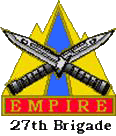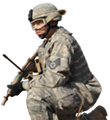 27th Brigade Combat Team
27th Brigade Combat Team
History of the 27th Infantry Division
|
 |
How far do you want to go back learning about the 27th Brigade? How about to the 1921 Division? There are PDF's compiled about the unit history of the 27th Division in 1921.
In 1912 the New York State National Guard was organized into a divisional format, which meant that groups of its regiments would be placed together under a larger organized unit, in a manner similar to that of the regular army. This new division would eventually become the 27th Infantry Division. On June 16th, 1916 the New York State National Guard Division was mobilized and moved to the Mexican border to participate in Brigadier General John Pershing’s sortie into Mexico. The division, known initially as the New York Division and then as the 6th Division remained in Mexico until March of 1917 when it was recalled to New York in preparation for possible service in Europe. In late April of 1918, the division was transported to Europe where it fought gallantly for the remainder of World War I.
Establishing divisions for the U.S. Army
In preparation for World War I, the U.S. Army established a numbering system to reflect Regular Army, National Guard and National formations that would be needed as the nation mobilized for war.
Numbers 1 through 25 were reserved for Regular Army divisions that were being formed around the limited numbers of active duty forces present in the Army at the time. Numbers 26 through 41 were reserved for National Guard units present in states that could support division formations and where combination of states could result in division-size formations, for example:
| 26th | “The Yankee Division” – Maine, New Hampshire, Massachusetts, Vermont, Rhode Island |
| 27th | “Orion” - New York |
| 28th | “Keystone” - Pennsylvania |
| 29th | “The Blue and Grey Division” - Maryland and Virginia |
| 30th | “Old Hickory” - North and South Carolina, Tennessee |
| 31st | Florida, Alabama, Georgia |
| 32nd | Wisconsin |
| 33rd | Illinois |
| 34th | “Red Bull” - Minnesota, Iowa, North and South Dakota |
| 35th | Kansas, Missouri and Nebraska |
| 36th | Texas |
| 37th | Ohio |
| 38th | Indiana |
| 39th | Arkansas |
| 40th | California, Colorado, New Mexico, Arizona, Utah |
| 41st | Oregon |
The number 42 was reserved in sequence for the nation’s first “All American Division,” which was created by selecting “elite” National Guard units from 26 states plus the District of Columbia. New York’s contribution to the “Rainbow Division” was the Fighting 69th Infantry re-designated as the 165th Infantry Regiment.
Gaps were deliberately left in the number sequences in anticipation of growth and changes, so the next series of numbers for National Divisions being formed as a result of conscription started with 70 and went from there.
Mobilization and Service in World War I
Called into federal service on July 15, 1917, the Twenty-Seventh Division hastily recruited to increase its numbers and late in August, was concentrated at Camp Wadsworth, near Spartanburg, SC, for intensive training. In the spring of 1918, the division began its movement toward embarkation camps. The division’s advance detachment left Hoboken on May 2 and arrived at Brest, France, May 10, 1918. Late in June the last units of the Twenty-Seventh Division had arrived safely overseas.
Until July 24 the division was in the final stages of training under British mentors, in Picardy and Flanders. On July 25th, the 27th Division less its artillery brigade and 102nd Ammunition Trains, occupied the Dickebusch Lake and Scherpenberg sectors in Flanders. In just over a month, this operation merged into the Ypres-Lys action, and then, from August 19 to September 3, the 27th was on its own.
The great Somme "push," lasting from September 24 to October 1, saw the 27th engaged in severe fighting along the Saint Quentin Canal Tunnel -- one of the out-lying strong points of the supposedly impregnable Hindenburg Line. Following heavy losses, the 27th was placed into reserve for rest and replacements at the conclusion of the first phase of the Somme Push. Six days later the Twenty-Seventh Division was back into action again, moving steadily toward Busigny on the heels of the retiring Germans.
The 27th Division had, in conjunction with British forces and the 30th Division, American Expeditionary Forces, had accomplished the supposedly impossible by cracking the vaunted Hindenburg line wide open.
The 52d Field Artillery Brigade and the 102nd Ammunition Train of the New York Division had not gone with the rest of the Twenty-seventh Division to the British front in Flanders. They had moved up on October 28, to support the Seventy-Ninth Division in the Argonne.
Meanwhile the Twenty-Seventh Division units which had seen heavy action in Flanders, had moved back to an area near the French seaport of Brest.
Composition of the Twenty-Seventh Division in WWI
- Fifty-third Infantry Brigade: 105th Infantry,106th Infantry, 105th Machine Gun Battalion
- Fifty-fourth Infantry Brigade: 107th Infantry, 108th Infantry, 106th Machine Gun Battalion.
- Fifty-second Field Artillery Brigade:104th Field Artillery (75mm), 105th Field Artillery (75mm), 106th Field Artillery (155mm), 102nd Trench Mortar Battery
- Divisional Troops: 104th Machine Gun Battalion, 102d Engineers, 102d Field Signal Battalion, Headquarters Troop.
- Trains: 102nd Train Headquarters and Military Police, 102nd Ammunition Train, 102nd Supply Train, 102nd Engineer Train, and 102nd Sanitary Train.
Between the Wars History of the 27th Division
After the war the 27th was reactivated back in the New York National Guard for peace time service, climaxed by participation in the First Army maneuvers of 1940.
Composition of the Twenty-Seventh Division between the Wars
- Fifty-third Infantry Brigade: 105th Infantry,106th Infantry
- Fifty-fourth Infantry Brigade: 107th Infantry,108th Infantry
- Fifty-second Field Artillery Brigade:104th Field Artillery (75mm), 105th Field Artillery (75mm), 106th Field Artillery (155mm), 102nd Ammunition Train
- Special Troops: Headquarters & Headquarters Co., 27 Military Police Co., 27th Signal Co., 27th Tank Co., 102nd Ordnance Co.
- Separate Units: 102nd Engineers, 27th Division Aviation (102nd Observation Squadron), 102nd Medical Regiment., 102nd Quartermaster Regiment.
World War II Service
The 27th Infantry Division was federalized for service on October 15th, 1940 and initially commanded by Major General William Haskell. At this time it still retained its WWI organization of two brigades and four regiments. The 53rd Brigade consisted of the 105th and 106th Infantry regiments while the 54th Brigade contained the 108th and 165th Infantry regiments. Following a lengthy period of maneuvers and training, the 27th was ordered to California in December following the Japanese bombing of Pearl Harbor. While in California the 27th awaited orders to ship out and concentrated on bringing itself up to the authorized field strength of 1,012 officers and 21,314 enlisted men. The division’s strength had been reduced by discharges to around 14,000 men. The first elements of the division boarded ships bound for Hawaii on February 27th 1942, the first Infantry Division to leave the states following Pearl Harbor.
The division remained on Hawaii for a number of months, during which time it was triangularized, with the 108th Infantry regiment being reassigned to the 40th Division. A division that has been triangularized has been given three infantry regiments instead of the four of a square division. This final reorganization dismantled the brigade structure and again dropped the division’s strength to 14,000 men. Following the reorganization, the 27th Division was shifted to Oahu, where it would relieve the 25th Infantry Division, which was slated to join the U.S forces fighting in Guadalcanal. For most of its time in Hawaii, the 27th was under the command of Brigadier General Ralph Pennel.
On November 20th 1942, the 27th Infantry Division embarked on its first combat assignment, the capture of the coral atoll of Makin. The 27th also had a new division commander, Major General Ralph Smith. Units from the 27th Division also occupied the Majuro atoll on February 1st 1944 and successfully assaulted Eniwetok Island on February 19th of the same year. In June 1944, the division landed on Saipan, where its regiments fought together for the first time as a full division. Following Saipan the division was rested and reinforced at Espirto Santo for seven months before any further operations. During this time the 27th received its final division commander, Major General George Griner Jr. On April 12th, 1945 the division landed on Okinawa, where it would remain until September when it was sent to Japan briefly for garrison duty. The division was mustered out in late December of the same year. Since its arrival in the Pacific, the 27th Infantry Division had suffered 1,512 killed in action, 4,980 wounded in action and 332 who later succumbed to their wounds.
General Smith had been removed from command following a dispute with the aggressive and eccentric Marine commander, General Holland “Howling Mad” Smith who had been in overall command of the Saipan invasion. Holland Smith claimed that Ralph Smith had disregarded orders and mishandled the 27th Division, prompting the relief order. Later court of inquiry showed that the charges were for the most part unsubstantiated and General Ralph Smith was quickly given a new command.
The 27th returned to the states for deactivation in December 1945, the longest serving National Guard unit.
Composition of the Twenty-Seventh Division in WWII
- Division: Headquarters & Headquarters Co.
- Infantry: 105th,106th and165th Infantry Regiments
- Artillery: Headquarters Division Artillery, 104th, 105th, 106th, and 249th Field Artillery Battalions
- Admin Support: Military Police Platoon., 727th Ordnance Company, 27th Quartermaster Company, 102nd Medical Battalion
- Tactical Support: 102nd Engineer Battalion, 27th Reconnaissance Troop, 27th Signal Company
Post World War II History of the 27th Division
After a short period of inactivity following the end of the war, the division was reconstituted along the lines of its war time structure with limited reorganizations.
 In February 1955 the 27th Division became the 27th Armored Division, retaining many of its former units.
In February 1955 the 27th Division became the 27th Armored Division, retaining many of its former units.
Composition of the Twenty-Seventh Division 1948 to 1954:
Division: Headquarters & Headquarters Co.
Infantry: 105th Infantry Rgt.,108th Infantry Rgt., 174th Infantry Rgt.
Artillery: DIVARTY, 156th Field Artillery Bn., 170th Field Artillery Bn., 249th Field Artillery Bn., 127th AAA Bn (from 106th AAA, from 7th AAA, from 106th of WW2).
Admin Support: 27th Military Police Co., 727th Ordnance Co., 27th Quartermaster Co., 134th Medical Bn., 27th Replacement Co.
Combat Support: 127th Tank Bn., 152nd Engineer Bn., 27th Recon Troop, 27th Signal Co.
Late 50's, 1960's the 27th Division's Armored Years
In February 1955 the 27th Division became the 27th Armored Division, retaining many of its former units.
Composition of the Twenty-Seventh Division 1955 to 1957:
Division: Headquarters & Headquarters Co., Combat Commands A, B, and C.
Infantry: 105th Armored Infantry Bn., 108th Armored Infantry Bn., 174th Armored Infantry Bn., 175th Armored Infantry Bn.
Armor: 127th Tank Bn., 205th Tank Bn., 208th Tank Bn., 274th Tank Bn.
Artillery: DIVARTY, 106th Armored Field Artillery Bn., 186th Armored Field Artillery Bn., 249th Armored Field Artillery Bn., 270th Armored Field Artillery Bn., 210th AAA Bn.(from 127th AAA)
Sep Units: 27th Armored Recon Bn., 152nd Armored Engineer Bn., 27th Armored Signal Bn.
Trains: Tn HHC, 727th Armored Ord Bn., 134th Armored Medical Bn., 27th Armored QM Bn., 27th MP Co., 27th Replacement Co.
By 1960 there were some changes in the designations of units, some additions and some deletions.
Composition of the Twenty-Seventh Division 1960:
Division: Headquarters & Headquarters Co., Combat Commands A, B, and C.
Infantry: Armored Rifle Battalions - 1/105, 1/108, 2/108, 1/174 Inf (175th AIB dropped)
Armor: Medium Tank Battalions - 1/127, 1/174, 1/205, 1/108 (274 Tk Bn Dropped) 1/210 Armor (from 210 AAA); 1 Recon Sqdn 121 Armor (ex 27th Recon)
Artillery: DIVARTY, Howitzer Battalions - 1/104, 1/180, 1/270 Arty; 1 Rkt Bn 106 Arty
Sep Units: 127th Avn Co (new), 152nd Engineer Bn., 227th Signal Bn (ex 27th).
Trains: Tn HHC, 727th Armored Ord Bn., 134th Armored Medical Bn., 27th Armored QM Bn., 27th MP Co., new- 227th Trans Det (Acft Maint), 527th Admin Co.
Composition of the Twenty-Seventh Division 1966
Division: Headquarters & Headquarters Co.
1st Brigade: 1/105 INF, 1/205 AR, 1/210 AR
2nd Brigade: 1/108 INF, 2/108 INF, 1/208 AR
3rd Brigade: 1/174 INF, 1/127 AR, 2/127 AR, 1/174 AR, 1 Sq/121 CAV (ex 121 AR)
Artillery: DIVARTY, 1/104 FA, 1/106 FA, 1/156 FA, 2/156 FA, 1/170 FA
Sep Command: HHC and Band, 27th Admin Co., 27th S&T Bn, 134th Med Bn., 152nd Engr Bn., 727th Maint Bn.
Composition of the Twenty-Seventh Brigade, 50th Armored Division 1968:
Brigade: Headquarters & Headquarters Co.
Combat Units: 1/127 AR, 1/174 INF, 1/108 INF, Trp B - 5 Sqdn/117 CAV, 1/156 FA
Cbt Support: Co C/104 Engr, Co C/50th Med Bn., Co C/50th Maint Bn., Det 1-Co B/250th S&T Bn, 127th QM Det.
In late 1967 or early 1968, the 27th Armored Division was deactivated and reorganized as a Brigade of the 50th Armored Division. Prior to this time the Combat Commands had been replaced by Brigades in the Armored Divisions. Many units were deactivated, and others were re-assigned to the command of the 42nd Infantry Division, also assigned to the New York National Guard.
The 27th Brigade was reconstituted as a Separate Infantry Brigade (Light) in the 1980s and was originally established as a "round-out" Brigade to the Army’s 10th Mountain Division (Light Infantry) at Fort Drum.
In the 1990s, the Army National Guard nationwide was reorganized and the 27th was established as one of 15 separate “Enhanced” brigades, subject to priority call up in the event of a federal mobilization.
In 1998, the 27th Brigade was committed to disaster recovery operations in the New York’s North Country following a devastating ice storm which struck in January. The 27th was called again for state emergency response in the wake of a destructive wind storm which struck Syracuse on Labor Day that year forcing an early close to the New York State Fair.
In the summer of 2001, the 27th Brigade deployed for an intense three-week training period at the U.S. Army’s Joint Readiness Training Center at Fort Polk, LA. Nearly 4,000 Soldier for the New York Army National Guard participated, making it the largest single exercise for the New York National Guard since World War II. The terrorist attacks of 9-11, 2001 struck within weeks of the units return home.
Following extensive state and federal active duty for Home Land Defense in response to the terrorist attacks of 9-11, 2001 subordinate units of the 27th underwent individual call ups for Operation Iraqi Freedom in 2003. In 2006, following the return of most New York National guard units from federal Active Duty in Iraq, the New York Army National Guard was “re-set” and the 27th was reorganized as an Infantry Brigade Combat Team.
 |
History of the Orion |
 |
The three letters together form the monogram N .Y. D., standing of course for "New York Division."


These seven stars represent the brighter stars of the constellation Orion. They are included in the insignia as a compliment to Major-General O'Ryan, who has commanded the New York Division for seven years. When these units are all assembled as shown here, we have the complete insignia of the 27th division (now the 27th Brigade) -- probably the most unique insignia of any American Army Unit.
Astronomy Played a Part In Designing Insignia Of 27th
From an unsigned article in the National Tribune, Thursday, December 21, 1933
Astronomy furnished the inspiration for the distinctive shoulder patch insignia of the Twenty-seventh Division, American Expeditionary Forces, writes Herbert E. Smith in the Army Recruiting News. The division of New York National Guard men adopted Orion, the Seven Sisters of the Pletsdes--as a part of its finished design for a shoulder patch. The design was approved in 1918.
On a circled background of jet black appeared these seven stars in red, with the monogram NYD (New York Division) likewise in red. The colors, black and red, also have special significance. The black stands for iron and the red for the blood.
| NEW | YORK | DIVISION |
 |
 |
 |
Another interesting coincidence lies in this design. The Orion corresponds with the name O'Ryan, the 27th Division Commander Maj. Gen. John F. O'Ryan, the general who took the New Yorkers over to Europe during World War One and brought them back.
Bibliography References for 27th Brigade's History
Contact the 27th BCT Webmaster @ ng.ny.nyarng.list.dmnawm@army.mil
URL: https://dmna.ny.gov/arng/27bct/?id=history
216.73.216.120
Page Last Modified: Feb 17, 23



 42nd Infantry Division
42nd Infantry Division NYNG on GKO
NYNG on GKO